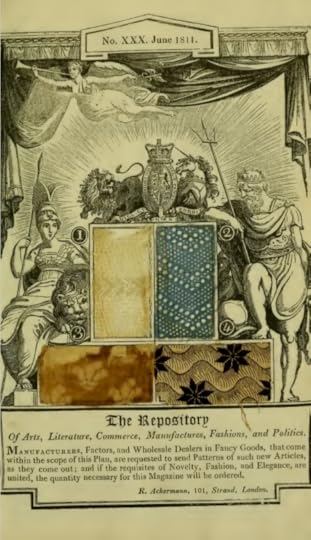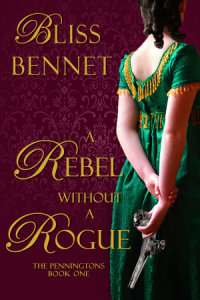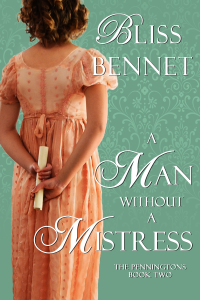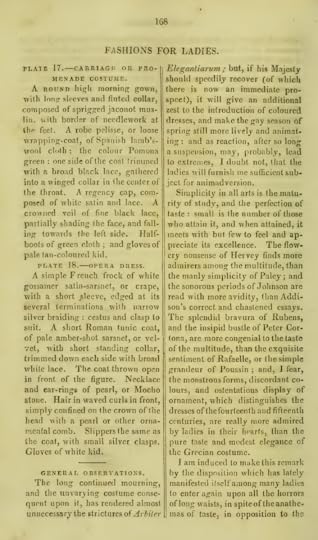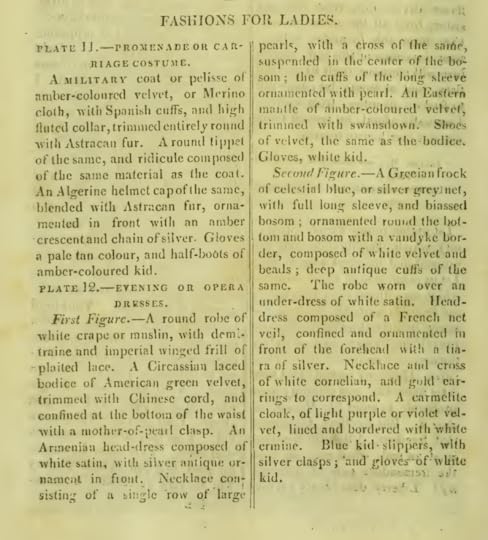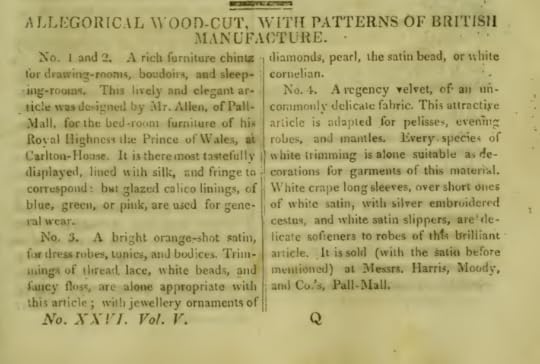Bliss Bennet's Blog, page 8
February 3, 2016
Ackermans Fashion Plates August 1811
Arbiter Elegatiarum must take the summer off; no words of fashion wisdom appeared in July 1811’s edition, nor in this month’s. The elegant ladies are off to the seaside, too, if the background and foreground illustrations in the first plate (sailboat and seaweed) are to be our guide. I’m still wondering if there was any meaningful difference between a “Promenade Dress” (see July 1811 post) and a “Walking Dress.” Anyone have any info here to share?
July’s plate featured a “youth,” but this month we’re back to a “child.” Although said child appears to be a boy, given his outfit. While it is described as “a short-sleeve Spanish vest and trowsers in one,” it has the look of a “skeleton suit,” a tight coat or jacket buttoned to a pair of high-waisted trousers. Skeleton suits, popular from the 1790s to the 1820s, were one of the earliest fashions to be designed specifically for children, rather than being an adult fashion simply made to a smaller size. Our child also sports a “college cap” of purple velvet, with a crimson band. As both Oxford and Cambridge’s official colors are blue, I wonder what university this young boy hopes to one day attend? Perhaps his colors indicate his preferred college within one of the universities?
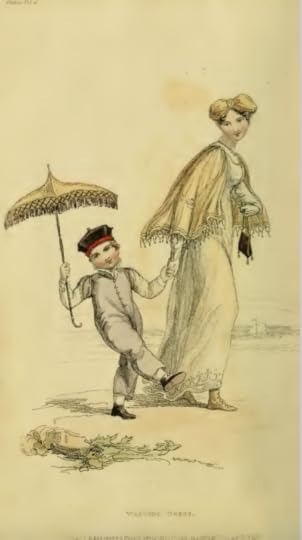
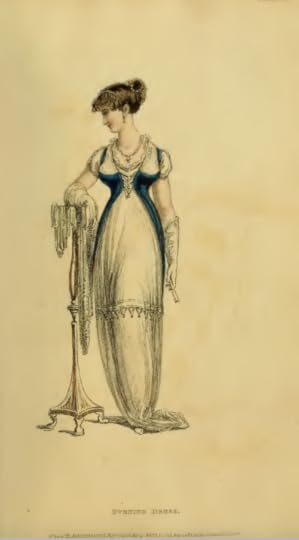
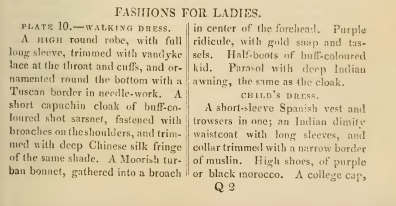

The colors of this month’s fabric samples seem to have faded badly over time, at least in samples #3 and 4. “A celestial blue pencil muslin” appears brown to my eye, although I can just make out the hint of pink in the muslin of #4. But those embossed dots are supposed to be green? Such an “animated article” as the pink with green spots should be “confined to the more youthful females, to whom it is most becomingly adapted,” the description asserts.
The “leno” fabric in sample #1 refers to a weaving technique in which warp yarns are arranged in pairs. Leno woven fabrics have an open weave, but one that is firmer and less prone to tearing due to this pairing (thanks to Fairchild’s Dictionary of Textiles for this information).
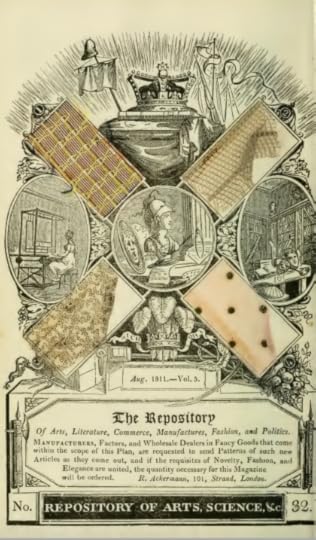
Vol. VI, no. xxxii
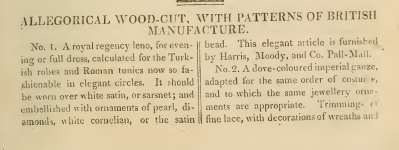

January 27, 2016
Ackermanns Fashion Plates July 1811
Time is of the essence to July 1811’s fashionable ladies: both include among their accessories a watch. The opera-bound lady will not be late if she keeps her “French repeating watch, with elastic gold chain and seals” wound. What is a “repeating watch”? A quick check of Wikipedia reveals that a “repeater,” which can refer to either a watch or a clock, chime the hours (and often the minutes) at the press of a button. Invented in the late 18th century, repeaters proved helpful for telling the time when one was in the dark, a handy feature when one lived in a time before electricity and/or gas brought artificial illumination to households. Because of their intricate, and tiny, mechanisms, repeater watches were much hard to craft than repeater clocks. Owning and displaying a repeater watch, then, clearly demonstrate that our opera-bound lady is not only fashionable, but well-to-do. The promenading lady’s timepiece is only listed as a “French watch.” Perhaps a repeater was too dear to take on a casual walk?

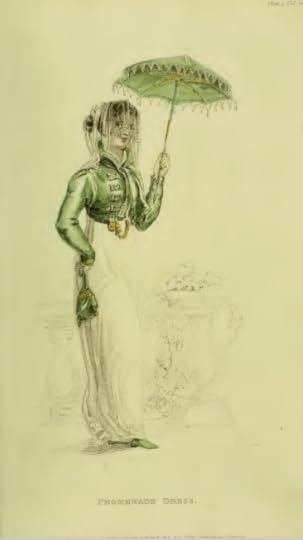
Beside our opera-loving lady stands a “youth,” the first time a fashion plate features a child whose gender is obvious. I don’t think one would bring a youth of this age to the opera, though, do you? Perhaps his “jacket and trowsers, à la Militaire” simply suggest that the opera mama is attending has a martial theme?
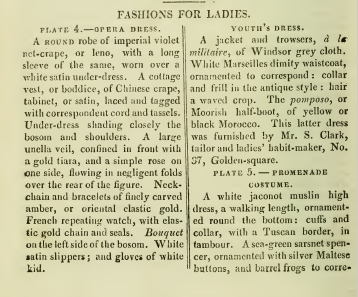

This month’s fabric samples feature a striking upholstery chintz, a floral printed on a background of “bright Sardinian blue.” And two evening dress fabrics, the latter, a “silver regency tissue,” worn by an unnamed beauty with “so much effect at the ground fête at Carleton-House.” I wonder who she was?
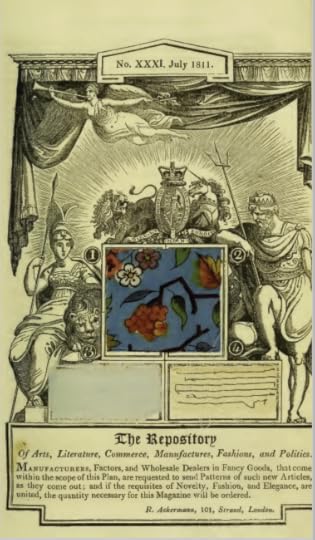

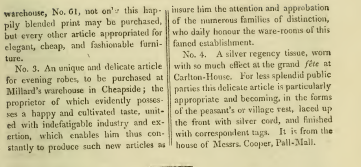
January 21, 2016
Guest Posting at Madame Gilflurt’s
Talking today about the Irish Rebellion of 1798 on A Covent Garden Madame Gilflurt’s Guide to Life:
http://www.madamegilflurt.com/2016/01...

January 20, 2016
Ackermanns Fashion Plates June 1811
Regency ladies are out and about in this month’s edition of the fashion plates: two promenade dresses, as well as five different fashionable headdresses. I’m especially taken by headdress #3, “composed in the antique or old English fly-cap, of crimson shot silk, finished at the edge with two rows of pearls or beads, and a star or small rosette in front.” It almost might be worth wearing a simple white gown, as Arbiter Elegantiarum advises, if you could top it all off with such a splendid creation.


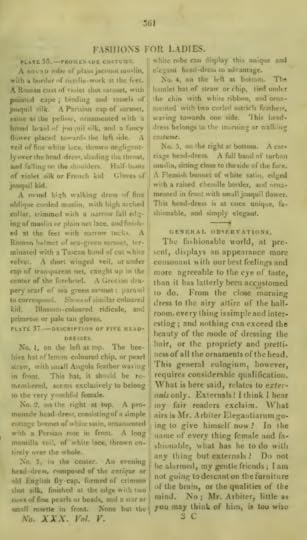
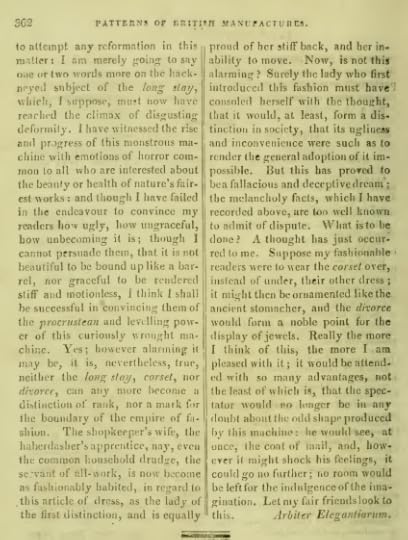
And this month, Arbiter Elegantiarum outs his gender. Yes, his—he refers to himself as “Mr.” Arbiter Elegantiarum throughout this post. And he continues his long-running rant against long stays, this time using a class-based argument:
“Yes; however alarming it may be, it is, nevertheless, true, neither the long stay, corset, nor divorce, can any more become a distinction of rank, nor a mark for the boundary of the empire of fashion. The shopkeeper’s wife, the haberdasher’s apprentice, nay, even the common household drudge, the servant of all-work, is now become as fashionably habited, in regard to this article of dress, as the lady of the first distinction, and is equally proud of her stiff back, and her inability to move.” His joking solution to this problem? “wear the corset over, instead of under, their other dress.” Don’t think many readers took his advice…
Would you wear a print named “The Regent’s Plume” (#3)? Or perhaps it is mean as a upholstery print; the brief description doesn’t specify. Nice that you can pay homage to the ruler-in-waiting with a fabric that is “reasonable in price.”


January 13, 2016
Ackermanns Fashion Plates May 1811
When I think of Regency dresses, I always think (inspired, no doubt, by the costumes in recent films of Jane Austen novels) of one piece gowns. But blogging about the Ackermanns Fashion Plates for the last year has made me realize that tunics featured more often in Regency dresses than I had previously imagined, even in fairly formal outfits. Take for example plate 31, which features an Opera Dress of white muslin, overlaid with an “Algerian tunic of white satin, trimmed round the bottom and bosom with net or silver fringe.” The length of the “Turkish coat,” too, seems unusual; not the short pelisse, nor the calf or full-length coat or cloak, but a “short” coat, one that reaches only to the knees. If you saw such an outfit in a Regency-period film, or on a Regency-set romance, would you think it looks out of place? (And do you think that child is accompanying his/her mother to the opera??)
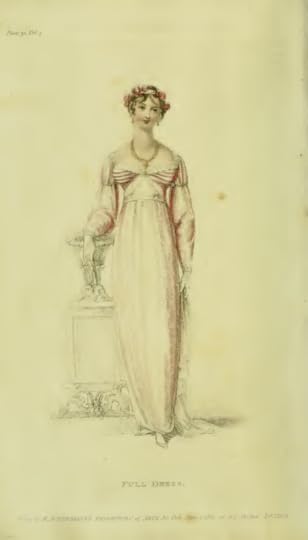
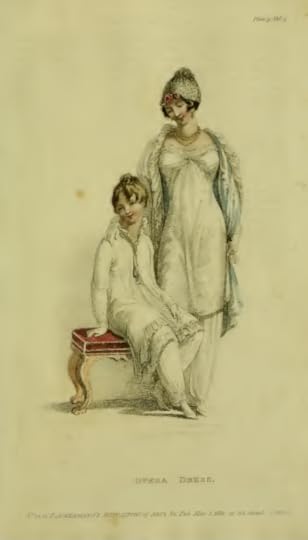

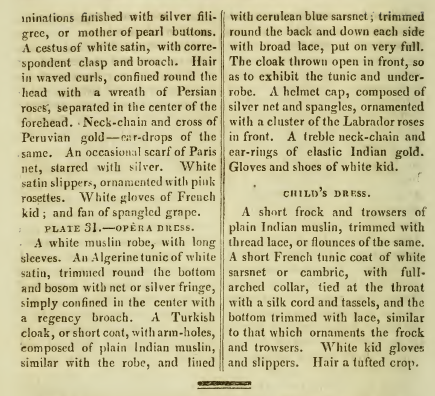
It looks as though the Philadelphia Museum of Art library’s copy of this issue had some water or other damage on the fabric sample page. I’m including a photo here, but you might want to check out this Pinterest image for a better look. Haven’t been able to find a definition of “pomerette” or “rainbow imperial net”; any takers?
January 6, 2016
Ackermanns Fashion Plates April 1811
No commentary this month from Arbiter Elegantiarum, only brief descriptions of the two fashion prints, one for a dress to wear to a ball, the other for a gown suitable to walking, all in colors that suggest that official mourning for the King’s dead sister has ceased.
May I have a pair of half-boots of violet kid??

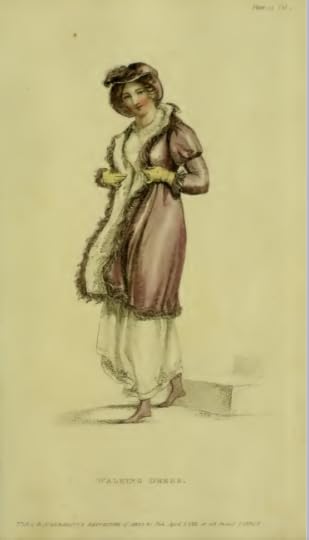
This month’s fabric samples also highlight the return to color, particularly the regency spotted muslin on “beautiful bottilla grounds” (#3). Does anyone know if “bottilla” refers to the color? Can’t find the word in my Fairchild’s Dictionary of Textiles, or in a Google search…
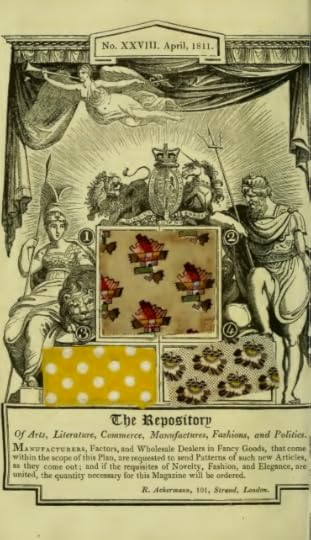
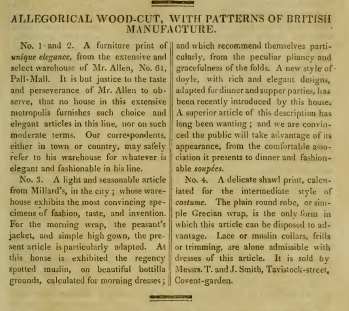
December 31, 2015
And the reviews keep coming…
It’s been so exciting to read the strong reviews being garnered by both A Rebel without a Rogue and A Man without a Mistress since their publication earlier this year. Thought I’d ring out 2015 by sharing some of my favorites:
For A Rebel without a Rogue:
“A sparkling debut.” — Historical Novel Society Indie Reviews
“Bennet’s historically, thematically rich romance bodes well for having another great, and they’re pretty scarce these days, historical romance writer to look forward to.” —Miss Bates, of the Miss Bates Reads Romance blog
“A beautifully written tale of the Irish Rebellion, justice, mistaken identity, vengeance, secrets, family, passion, redemption, betrayal, healing, and so much more. Finding love and romance amidst much turmoil, prejudice and injustices. I find this story mesmerizing, intriguing and fascinating with Irish fanatics and dangerous situations . . . . Fans of Historical Fiction, historical romance, the Irish Rebellion, passion, romance, and love will enjoy this dangerous but compelling story. A wonderful read!” — My Book Addiction Reviews
“After their first emotionally charged kiss, I found myself sucked into such an emotionally complex relationship that I was very surprised. It’s such a dance of outside, societal influences and deep, tearing emotions that the reader can’t help but feel every glance or embrace. . . . I’d definitely recommend this one to historical fiction lovers. It’s something different than your typical Regency era book and a great read.” —Montana Bookworm
“ The author has done an excellent job researching and portraying historical facts from the Irish Rebellion. She has integrated history into a perfect work of fiction mixed in with vengeance, mystery, betrayal, and love. Mrs. Bennet’s heroine is broken and unloved but has many redeemable qualities. The hero is young and naive but together they work. She also writes secondary characters in a way that leaves the reader wanting to know more about them. As a whole this is a story I would highly recommend to anyone who likes history in their romance, a story that brings two very unlikely people together and creates a love that could last a lifetime.” — Alwyztrouble’s Romance Book Reviews
“If you are a real history lover then this is definitely the book to read. If you love the agony of emotion and heart then you will absolutely not want to miss this story!” — Swedenmom (amazon review)
A beautifully written love story that has everything you want in a great historical romance with heart wrenching emotion, heartbreak and a great HAE. Really enjoyed this book, cannot wait for the next one in the series.” — Jaci (Goodreads)
“Excellent Story. I enjoyed the strong characters…and I was so engrossed that I didn’t want to sneak / spoil the story by looking at the end. I’ll be looking for more books by this author :)” —Mary Hart (Goodreads)
For A Man without a Mistress:
“Bennet skillfully weaves mystery, political history, and romance together in this captivating novel. She surprises the reader by including in this story with its threads of grief, guilt, and grimness a couple of humorous scenes that reminded me of my favorite scene in Georgette Heyer’s The Unknown Ajax. But I think her finest achievement is the heroine who remains unconventional to the end even when she cooperates in the most conventional of romance fiction’s elements: the HEA.” — Janga, Heroes and Heartbreakers blog
“A Man Without a Mistress, the second of Bliss Bennet’s Pennington series, is savvy, sensual and engrossing, and manages a spot-on balance of realism and buoyancy. The hero and heroine are refreshingly equal in all but their gender — they’re a couple of resourceful, damaged, wry, intelligent, lonely and delightful messes.” — Kathy Altman, USA Today’s Happily Ever After Blog
December 16, 2015
Ackermann’s Fashion Plates March 1811
Arbiter Elegantarium notes that he’s not had need of commenting on the current state of fashion in recent issues, as mourning for Princess Amelia still continues. The mourning period is likely to be lifted soon, he states, and anticipates the bloom of color in spring with pleasure, both for the variety they will offer, and the likelihood of witnessing extremes, which will provide him with “sufficient subject for animadversion.” Ah, how AE loves to censure the foibles of the fashionable world…


*Plate 18 recommends adorning oneself with a necklace and earrings of pearl, or “Mocho stone.” I hadn’t heard of the latter, but a check of Thomas Sheridan’s A Complete Dictionary of the English Language revealed it to be: “nearly related to the agat kind, of a clear horny grey, with delineations representing losses, shrubs, an beaches, in the substance of the stone.” Or, in modern parlance, dendritic agate.
Dress goods dominate this month’s fabric samples, with a bright “permanent morone printed cambric” (morone = crimson or maroon), and two figured shot-sarcenets, one dark green, one creamy white. The abstract figures of sample 4 seem quite modern, don’t they?
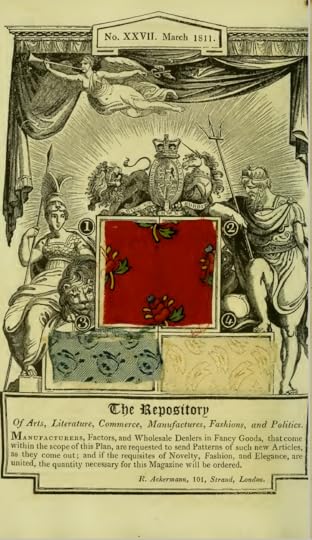
Vol. V, no. xxvii, page 175
December 9, 2015
Ackermans’s Fashion Plates February 1811
No commentary this month, just descriptions of the costumes in two plates. One of a Walking Dress, or Carriage Costume, the other featuring two Opera Dresses. The Walking Dress is described “trimmed with Astrakan fur”; the tippet and “ridicule” are made of the same. I’d heard the word “Astrakan” before, but I wasn’t quite sure what it referred to. The OED uses the spelling “astrakhan,” and includes two definitions: “The skin of still-born or very young lambs from Astrakhan in Russia, the wool of which resembles fur”; “A kind of cloth used chiefly as an editing or trimming for garments.” The latter definition, though, dates from 1887, so I’m guessing we’re talking about poor little lambs here.
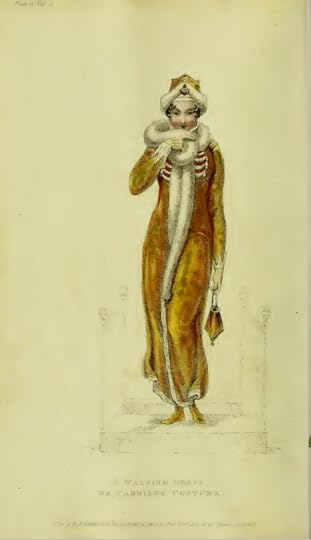

Want to decorate just like a Prince? Well, this month you can, for February 1811’s fabric samples includes a chintz “designed by Mr. Allen, of Pall-Mall, for the bed-room furniture of his Royal Highness the Prince of Wales, at Carleton-House.” How many members of the ton do you think rushed out to visit Mr. Allen for a sample?
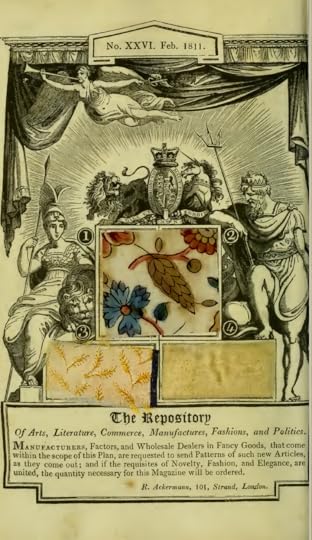
Vol. V, no. xxvi, page 111
December 2, 2015
Ackermanns Fashion Plates January 1811
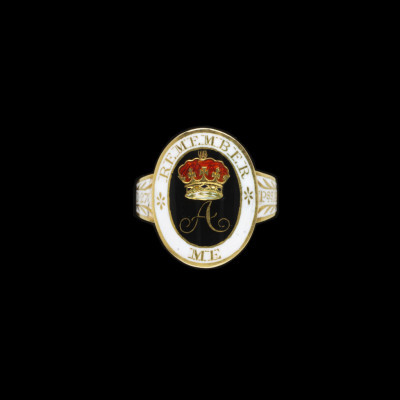
One of the 52 mourning rings the Prince Regent commissioned on the death of his sister, Princess Amelia
The theme of mourning continues from last month’s Repository to this one. Princess Amelia, daughter of King George III and Queen Charlotte, died the previous November. I’ve read that a protocol officer of the court typically decreed the degree and length of official mourning when a member of the royal family died, but I haven’t been able to find any mention of the specific length of public mourning decreed for the 27-year-old princess. Perhaps a month? Ackermann’s prints for January showcase both full and partial mourning outfits:
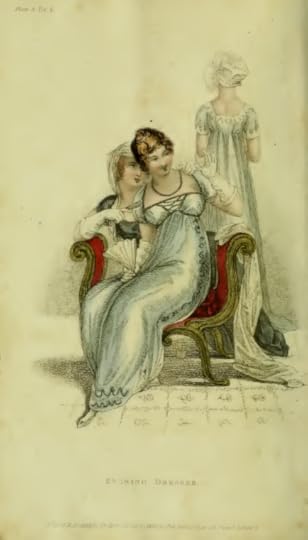

And this month’s fabric swatches tend more toward the silvery-blue than to straight black (and even the black sample is deemed “particularly adapted for half-mourning dress”). The silvery polka dot (“grey embossed satin”) is quite lovely, don’t you think, even if you’re not in second mourning.

